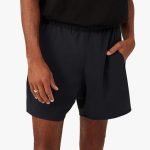This is an edition of the newsletter Pulling Weeds With Chris Black, in which the columnist weighs in on hot topics in culture. Sign up here to get it in your inbox every Thursday.
I was at The Standard in London having a coffee with my old friend Callum, and we were discussing my upcoming trip to Copenhagen. The conversation, as it often does, veered into clothing, and I mentioned my affection for Mfpen, the brand started in 2015 by Sigurd Bank. Callum fired off an email introduction to Sig, and we made plans to get together.
Scandinavian design is often thought of as a stoic take on minimalist simplicity. But it also has elements of functionality, timelessness, and quality—aspects that can be traced throughout the region’s rich history of architecture and furniture design. It is distinct, but sometimes I wish it had just a little bit more flavor. Thankfully, Mfpen does just that.
Mfpen (pronounced em-eff-pen) is having a moment right now, and for good reason. The clothes, made in Italy from deadstock fabrics, feel elegantly relaxed. As we mercifully move past the logo-heavy streetwear and sneaker boom into something a little more classic, Mfpen offers something sophisticated without being fussy. It’s relaxed, loose, well-made clothing for every day, it’s not hard to understand, and it’s infinitely wearable. It doesn’t ignore the classic Scandinavian principles, but it modernizes them in a clever way. Bank is a character. He says what he means and has a sense of humor. The clothes are cool because most of his interests lie outside of fashion. He is a guy you want to hang out with.
The brand’s space is in the city center, with a view of the famous Storkespringvandet fountain, and is large enough to house it’s office, studio, and the Mfpen Apartment Shop. It’s on a walkable street stuffed with tourists and flanked by luxury designer stores. When I arrived, I couldn’t find the exact number, but then I heard my name being called. I looked up, and Sig leaned out of a window, pointing me to the entrance. It’s above a pub—I had to push by a four-top of eager day drinkers to get to the door. An assistant brought me a coffee in a mug with her own face on it. The vibe is familial, and everyone seems happy and down to chat. The stereo played Slowdive, and I felt right at home as I flicked through the collection, which included a women’s line for the first time. Afterward, we caught up about the charm of Copenhagen (when the sun is shining), running a business, and not giving a shit.
GQ: I want you to explain Copenhagen to me, because I tried to understand it, but I don’t think I got it.
Sigurd Bank: The main issue when you were here was probably the weather. With everything Copenhagen has to offer, it has 10 times more to offer when the weather’s good. Everything is within walking or biking distance, so you don’t get in a cab to go somewhere. So when the weather is great, it’s easier to bike or go swimming or see women in short dresses or whatever.
When I visited the studio, I really loved the part of town it was in because I like to be in the mix like that. So where is it, exactly, and why did you choose that?
It’s the oldest part of the city, right next to Christiansborg, which is the parliament building, and it’s around the corner from the queen’s house with the canals and the stock trade. Our studio is next to the main shopping street where you have Louis Vuitton and Gucci and all that shit.
Where you belong.
But with that said, it was not a chosen location. We would rather be in Nørrebro or Vesterbro. But the space we have, it’s so cheap and big.
The space didn’t feel like anything else I experienced in Copenhagen. You guys have the office there. Obviously, you design there, but there’s also a store element.
Initially, we had too much space, and I said, “Fuck it. Let’s make a small shop.” But it’s very, very hard to find on the second floor. We have to pay drunk German tourists to get in the entrance. We don’t lose any money on the store, but the fact that the people have to come up makes it a hidden gem somehow.
Yeah, it makes it feel like you discovered something. I know you’ve done everything in the business, but do you still like to do everything, or do you just want to design clothes?
No, I hate the fact that I still have to do so many things. For some reason, there’s more and more and more I have to do. We were just hiring a new employee, and I’m sitting with the contract, and it’s just a lot of bullshit. But the bigger the team gets, the more I can focus. There was a point where I really had too much work, so we started hiring people, and the workload lessened. Now I can start focusing on the things that I want to do and the things that I’m good at.
The fun stuff. You should only do what you’re the best at, but when you own a business, that doesn’t really apply.
I saw a documentary about this guy who had a Michelin-star restaurant, and I joked to my girlfriend, “He’s as much a chef as I’m a designer.” The guy did not make any food. It was just difficulties with getting the supplies and dealing with the staff. It’s the same for me. The actual designing part is far away sometimes.
You seem to have a lot of interests outside of fashion, and you don’t seem like a dork about it, which makes everything a lot cooler.
I’m not into fashion, but I really enjoy garments and fabrics. That’s where my interest and love is. Of course, I somehow follow what’s going on. But the new creative director of Louis Vuitton, I could not give less of a shit. That shitty new collab or that new sneaker or whatever, I honestly don’t care. But it’s hard not to see these things because it’s what’s going on in your business.
I wear the clothes, I really like them, and a lot of my friends do, too, but it feels unaffected by what’s going on. This shit looks good, the fabrics are cool, and that’s it. It’s not a bigger production, and there’s not a lot of trend following.
We have three people in the creative part of the business, and I’m the head of the creative direction, but a lot of that work is on that fine line where something feels overdesigned. Like, “Do we need that cut on the shirt?” What makes Mfpen special is how we style everything and the fabrics we choose.
The fit and the fabrics are the big factors, as opposed to all the things that other people have to do to sell their stuff.
We have a successful company but in our own little pond. Some companies sell thousands of sweatshirts with their logo on them, but we’re happy if we sell 200 of a shirt.
Do you want to keep it that way, or do you want to take over the world?
No, no, no. More money, more problems. I like my company the size that it is. If we have to grow with more employees, then there will be more problems, and I’ll be further away from what I like to do.
In America, we’re taught that’s just what you do. You want to fucking crush it. It’s how I’m wired, for sure, and I know that’s bad sometimes, but I feel like it’s a cultural difference.
Instead of growing the business, we just want to make it more dense, if that makes sense. That means working with better retailers and adding more product groups instead of making bigger collections— we just started making a women’s line.
I saw the women’s line, and it looked great. Is that harder or easier to design?
The creative direction for us felt quite easy. We had a lot of discussions about how it needed to feel the same as the men’s, but different, so it wasn’t just menswear sized down. It needed to be feminine but still exist in the same realm. I had to hire a womenswear designer because, as a man, you just have no idea. I think a lot of male designers think they have an idea, but then you talk to women, and it’s like, “Fuck, we hate these briefs,” or “It makes you look fat.” It’s all these things that I know nothing about.
When I was in the studio, you were listening to music that I quite liked, which I often don’t encounter. Do you play music, or are you just an appreciator?
My mom is an organ player, so I grew up in a house with a piano, so I played the piano since I was maybe two. But when I was a teenager, my career goal was to become a bass player— double bass. But then I got to my older teens, and I found out that the bass player isn’t the hot one.
You found out that you should have learned guitar?
Yeah. But I think the teenage years shaped me in a different way. You have to practice so much, which is cool, but I just lost focus. But I’m very much into music, and we listen to it all the time at the office. We had a job interview the other day, and my colleague was like, “Hey, do you know we’re going to listen to music every single day? Because that’s part of being in our office!”
“You’re either going to like it, or you’re not.”
Sometimes I play hardcore. I’m a big fan of everything from Full of Hell to Converge.
I’m a big Converge guy. I grew up listening to hardcore. That was my entire life from middle school on. It shaped me in a lot of ways, but it’s hard for me to listen to it as an adult. I don’t have the angst. But did you see those bands? Were they coming to Denmark when you were a kid?
Maybe. I was not a part of that scene. I was just skating.
So you weren’t coming to Copenhagen all the time when you were younger?
Only in my teens. When I started, I was mostly coming for graffiti.
So we do it all. We skate, we do graffiti, we listen to hardcore. You’re checking all the boxes!
I was bad at skating. What’s the saying? Where two axes meet each other? I spent too much time getting hurt without doing the trick. They met too far apart.
Graffiti, though, were you prolific? What was the style? Were you doing fill-ins, throw-ups? What’s the vibe?
Bombing.
How many times did you go to jail?
None.
Damn, I’m impressed. But maybe that’s an American thing.
Check out our other free newsletters: Cam Wolf on watches, Samuel Hine on the fashion world, and more.



